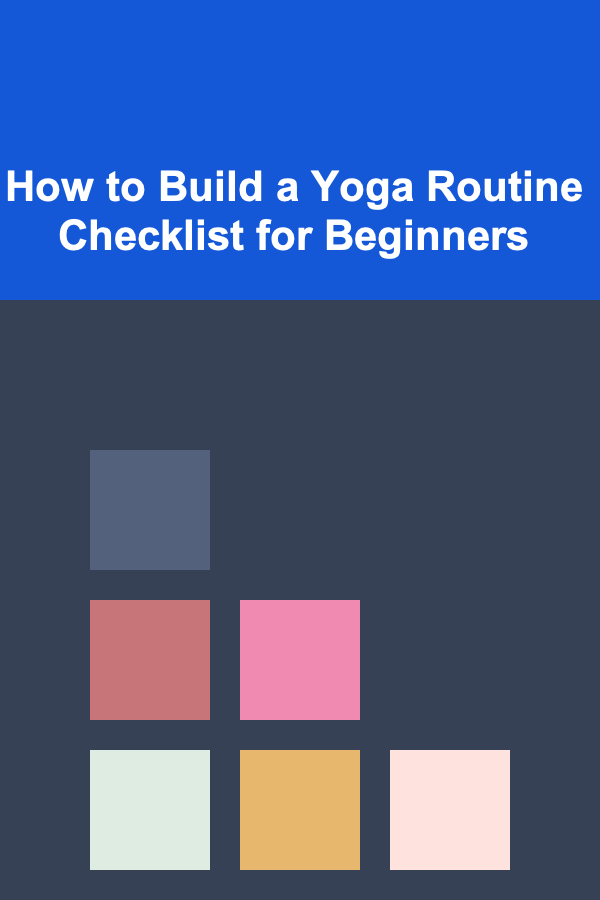
How to Build a Yoga Routine Checklist for Beginners
ebook include PDF & Audio bundle (Micro Guide)
$12.99$11.99
Limited Time Offer! Order within the next:

Yoga is a practice that has been cherished for thousands of years for its physical, mental, and spiritual benefits. It is an excellent way to increase flexibility, build strength, relieve stress, and improve overall well-being. For beginners, however, the vast range of poses, techniques, and styles of yoga can feel overwhelming. Creating a yoga routine checklist can help beginners navigate the practice and establish a consistent, sustainable routine.
In this article, we will guide you step-by-step on how to build a personalized yoga routine checklist, addressing essential aspects such as setting goals, selecting poses, understanding the importance of breathwork, and ensuring that your practice is balanced and safe.
Understanding Yoga: A Holistic Practice
Before diving into the technicalities of building a yoga routine checklist, it is crucial to understand what yoga is and how it integrates mind, body, and spirit. Yoga, in its essence, is not just about performing physical postures (asanas), but also about connecting with the mind through breathwork (pranayama) and meditation (dhyana). It encourages mindfulness, presence, and awareness, which make it a holistic practice.
For beginners, it's important to approach yoga with an open mind, acknowledging that it is a journey rather than a destination. Whether you're aiming to enhance flexibility, reduce stress, or increase strength, your yoga practice should evolve with your needs and progress.
Steps to Build a Yoga Routine Checklist for Beginners
Building a yoga routine checklist for beginners requires thoughtfulness and clarity. This checklist will guide you through the essentials, including how to structure your sessions, which poses to include, and the importance of consistency. Let's begin by breaking down the essential elements of a beginner-friendly yoga routine:
1. Set Clear Goals for Your Yoga Practice
Before you begin creating your routine, it's important to set clear and achievable goals. Think about what you want to accomplish with your practice. Do you want to:
- Improve flexibility?
- Build strength?
- Reduce stress or anxiety?
- Enhance balance and coordination?
- Improve posture and alignment?
Your goals will help guide the types of poses and techniques to include in your routine. For example, if your goal is to improve flexibility, you may want to incorporate more stretches and deep hamstring or hip openers. On the other hand, if strength building is your priority, you may focus on poses that target the core, arms, and legs.
2. Consider the Time Commitment
As a beginner, it is important not to overwhelm yourself with an overly ambitious routine. Yoga should be accessible, not intimidating. Consider how much time you can realistically dedicate to your practice.
- For beginners, starting with 20-30 minutes per session is ideal.
- If you are pressed for time, even a 15-minute daily session can help improve your flexibility and mental clarity over time.
You can gradually increase the duration as your flexibility and comfort level grow. The key is consistency, so aim to practice regularly, even if it's just a short session.
3. Create a Balanced Yoga Routine
A balanced yoga routine for beginners should target all areas of the body, promote mental clarity, and cultivate relaxation. A typical yoga session includes several components:
-
Warm-up
The warm-up is essential to prepare your body for the physical practice. A proper warm-up prevents injury by gradually increasing circulation and flexibility.
-
Asanas (Postures)
The bulk of your practice will consist of yoga poses (asanas). These should be well-rounded and accessible for beginners, incorporating both strength-building and flexibility-enhancing poses.
-
Breathwork (Pranayama)
Focusing on breath is an integral part of yoga. Proper breathing helps improve focus, reduce stress, and enhance physical performance in the poses.
-
Cool-down and Relaxation
Ending your session with a cool-down and relaxation is essential for releasing tension and calming the nervous system. A short meditation or relaxation pose like Savasana (Corpse Pose) is ideal.
4. Select Beginner-Friendly Yoga Poses
For beginners, starting with simple and foundational poses is key. These poses will help you build strength, increase flexibility, and improve balance without overwhelming your body. A good yoga checklist should include a combination of standing poses, seated stretches, balance postures, and core work. Here are some beginner-friendly yoga poses to consider:
1. Mountain Pose (Tadasana)
This standing pose is the foundation for all standing poses. It helps with posture, alignment, and grounding.
How to Perform:
- Stand with feet hip-width apart, toes pointing forward.
- Engage the legs, lifting the kneecaps and firming the thighs.
- Relax the shoulders down and keep the chest open.
- Extend the arms by the sides with palms facing forward.
- Keep the head aligned with the spine and take deep breaths.
2. Downward-Facing Dog (Adho Mukha Svanasana)
A classic yoga pose that stretches the entire body, particularly the hamstrings, calves, and spine. It also strengthens the arms, shoulders, and core.
How to Perform:
- Start in a tabletop position with hands and knees on the floor.
- Lift your hips toward the ceiling, forming an inverted V shape.
- Keep the arms straight and press the heels toward the floor.
- Keep the head relaxed, and focus on deep breathing.
3. Cat-Cow Pose (Marjaryasana-Bitilasana)
This dynamic stretch helps improve spine flexibility and warms up the back and neck muscles.
How to Perform:
- Start on hands and knees in a tabletop position.
- Inhale to drop the belly, lifting the chest and tailbone (Cow Pose).
- Exhale to round the spine, tucking the chin toward the chest (Cat Pose).
- Repeat, moving with your breath.
4. Child's Pose (Balasana)
A resting pose that helps relax the back, hips, and shoulders. It is great for calming the nervous system and allowing for rest during a practice.
How to Perform:
- Kneel on the floor and lower your hips toward your heels.
- Reach your arms out in front of you or rest them by your sides.
- Rest your forehead on the mat and breathe deeply.
5. Warrior I (Virabhadrasana I)
This powerful standing pose builds strength in the legs and arms while improving balance.
How to Perform:
- Start in a standing position and step one foot back.
- Bend the front knee while keeping the back leg straight.
- Reach your arms overhead and turn your hips forward.
- Hold for several breaths, then switch sides.
6. Bridge Pose (Setu Bandhasana)
Bridge Pose strengthens the glutes, hamstrings, and lower back while opening the chest and hips.
How to Perform:
- Lie on your back with knees bent and feet flat on the floor, hip-width apart.
- Press through the feet to lift your hips toward the ceiling.
- Keep your arms by your sides with palms facing down.
- Hold for several breaths, then slowly lower.
7. Savasana (Corpse Pose)
This final relaxation pose is essential to calming the body and mind after your practice.
How to Perform:
- Lie on your back with arms by your sides, palms facing up.
- Allow your feet to fall open and focus on your breath.
- Relax your entire body and clear your mind.
5. Incorporate Breathwork (Pranayama)
Breathing is an integral part of yoga that enhances both physical performance and mental focus. Breathwork (pranayama) helps oxygenate the body and release tension, making it essential for beginners to incorporate into their routine.
Some simple pranayama techniques include:
- Ujjayi Breath (Victorious Breath): This involves breathing deeply through the nose while slightly constricting the throat, creating a gentle, ocean-like sound. It is commonly used throughout the yoga practice to help maintain focus.
- Nadi Shodhana (Alternate Nostril Breathing): This technique involves breathing through one nostril at a time, which helps balance the body's energy and calm the mind.
- Deep Belly Breathing: Inhale deeply through the nose, expanding the belly, and exhale slowly through the mouth. This technique helps reduce stress and anxiety.
6. Create a Consistent Practice
As a beginner, consistency is key to progress. It's better to practice regularly for shorter periods (e.g., 20-30 minutes a few times a week) rather than pushing yourself to do long sessions sporadically. Over time, you'll begin to notice the positive effects on your body and mind.
7. Focus on Alignment and Safety
Yoga is about connecting with your body, and it's important to pay attention to alignment and form. Incorrect alignment can lead to discomfort or injury, especially when performing poses that involve flexibility or balance. Consider taking a few classes with a qualified yoga instructor who can help guide your form and provide corrections as needed.
8. Use Props for Support
Yoga props, such as blocks, straps, and cushions, can help you perform poses with proper alignment and make the practice more accessible. Don't hesitate to use props, especially if you're new to yoga, as they can support your body and prevent strain.
Conclusion
Building a yoga routine checklist for beginners is a process that requires patience, awareness, and mindfulness. By setting clear goals, creating a balanced routine, selecting beginner-friendly poses, and incorporating breathwork, you can develop a consistent practice that supports your physical, mental, and emotional well-being. Always remember that yoga is a journey, not a destination, and every step you take on the mat contributes to your overall growth and self-awareness. Stay committed, listen to your body, and enjoy the transformative power of yoga.
Reading More From Our Other Websites
- [Home Maintenance 101] How to Choose the Best Air Conditioner for Your Space
- [Rock Climbing Tip 101] Footwork Fundamentals: How to Master Climbing Technique from Day One
- [Home Staging 101] How to Use Seasonal Decor to Enhance Your Home's Appeal
- [Home Maintenance 101] How to Keep Your Home's Air Quality at Its Best
- [Personal Financial Planning 101] How to Automate Your Finances for Stress-Free Money Management: A Guide to Setting Up Recurring Transfers and Savings
- [Home Space Saving 101] How to Create More Space in Your Garage with Smart Storage Solutions
- [Home Budget Decorating 101] How to Make a Room Feel Bigger on a Budget: Space-Saving Tips
- [Digital Decluttering Tip 101] Mindful Tech Use: Building Healthy Habits for the Digital Age
- [Gardening 101] Designing a Flower Garden: Creative Layouts and Color Schemes
- [Organization Tip 101] How to Organize Your Time with a Planner or Calendar

How to Explore EV Charging Apps and Features
Read More
How to Layer Lighting for a Perfect Ambiance in Your Home
Read More
How to Make Money Online as a Geotechnical Engineer: 10 Actionable Ideas
Read More
Top Tips for Successfully Utilizing Online Marketplaces for Buying and Selling
Read More
How to Find Your True North Through Meditation
Read More
How to Understand Bonds as an Investment
Read MoreOther Products

How to Explore EV Charging Apps and Features
Read More
How to Layer Lighting for a Perfect Ambiance in Your Home
Read More
How to Make Money Online as a Geotechnical Engineer: 10 Actionable Ideas
Read More
Top Tips for Successfully Utilizing Online Marketplaces for Buying and Selling
Read More
How to Find Your True North Through Meditation
Read More